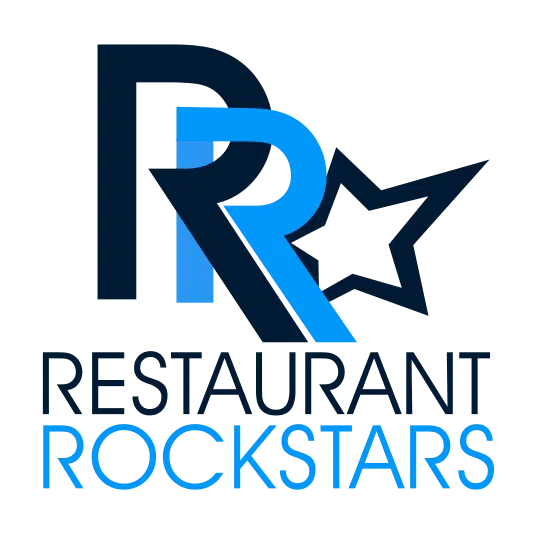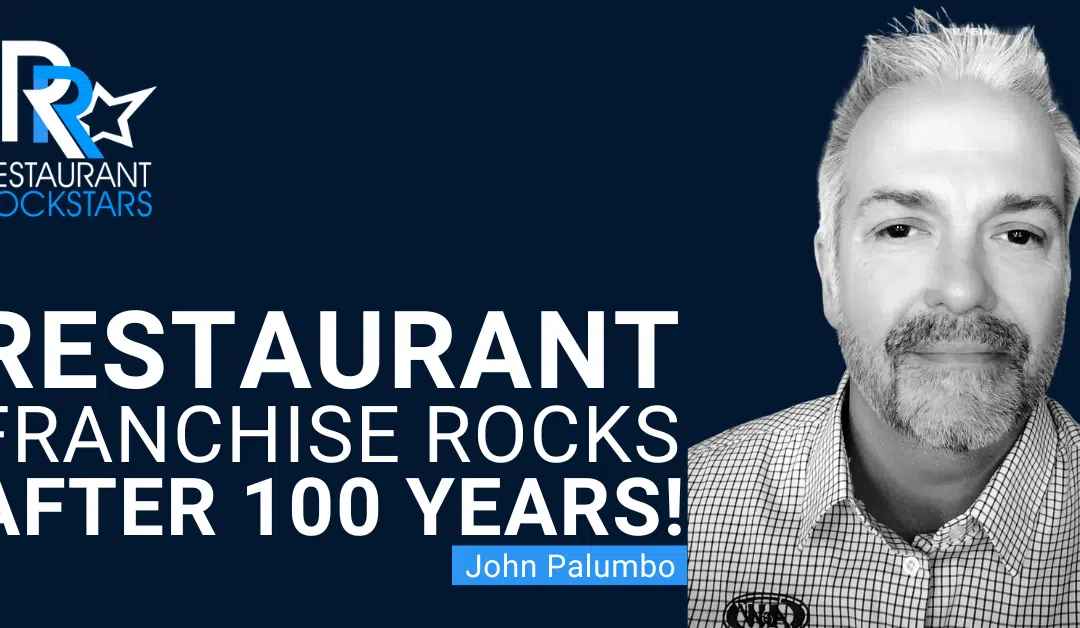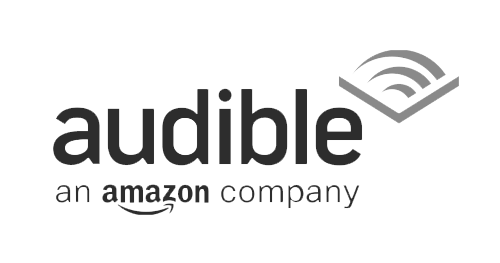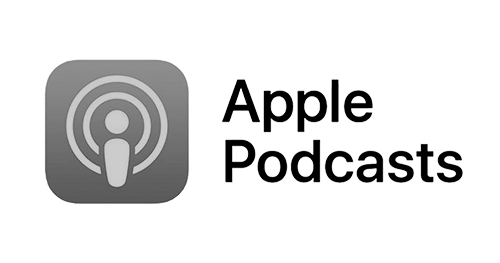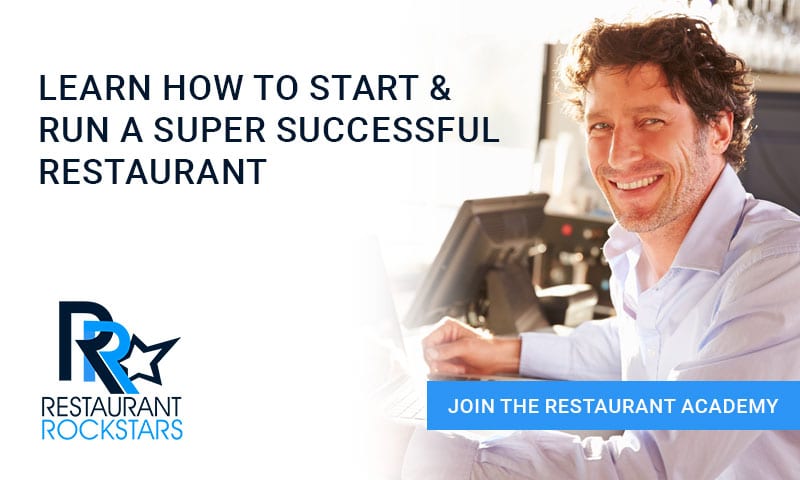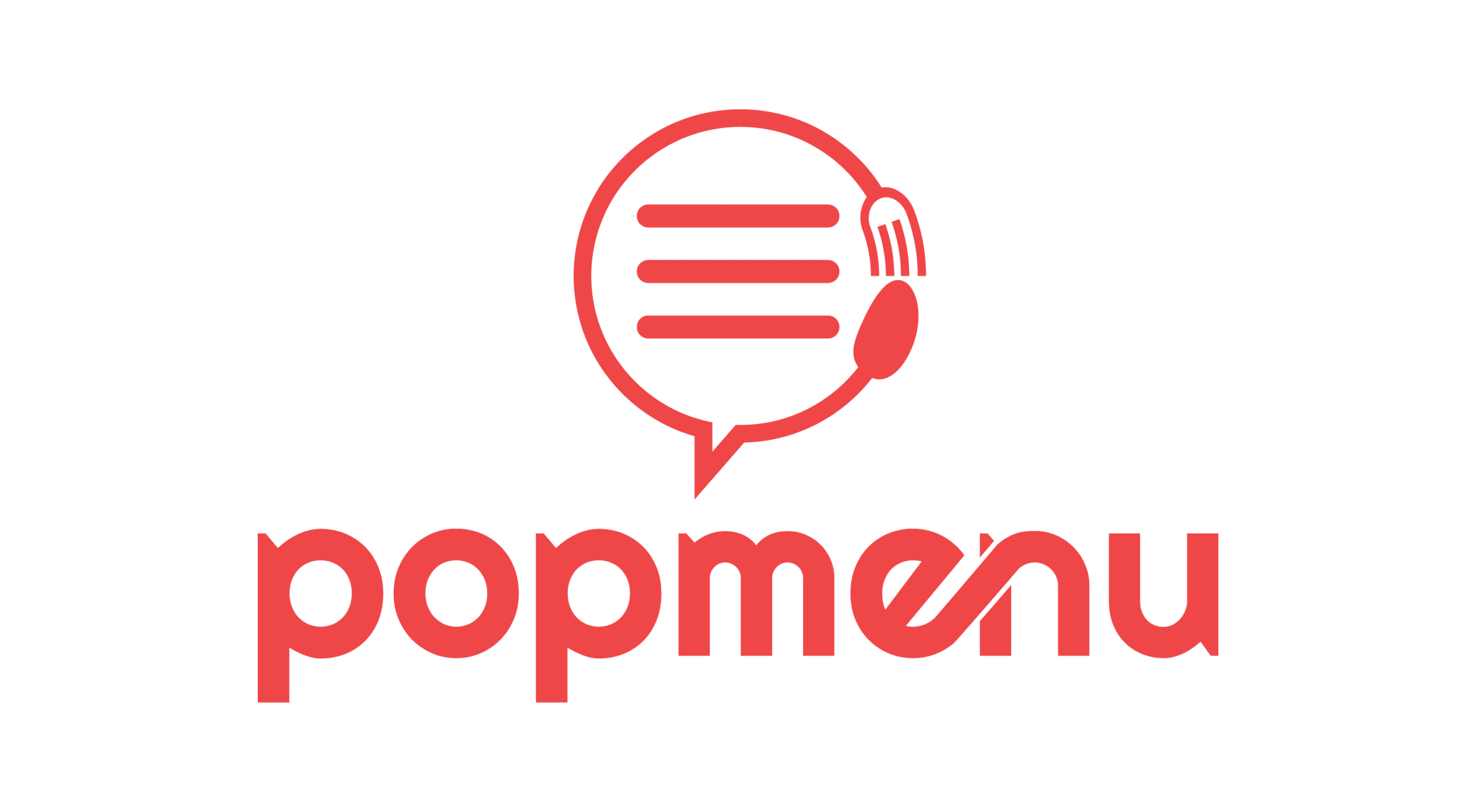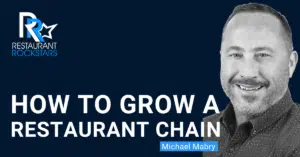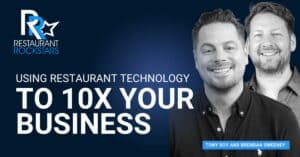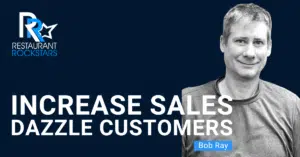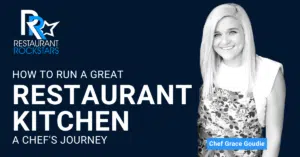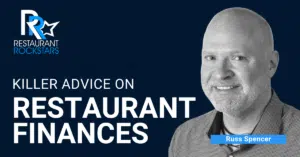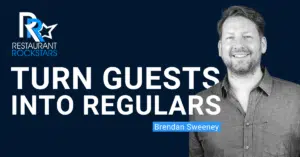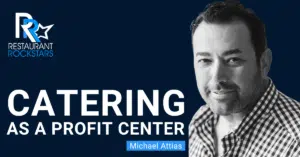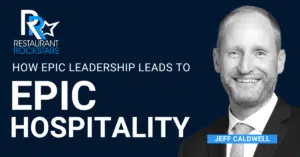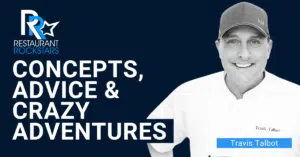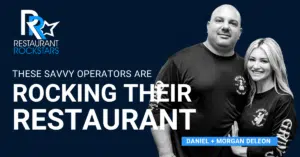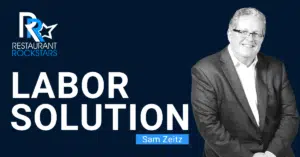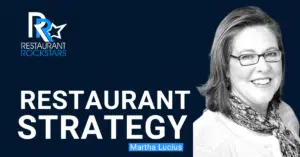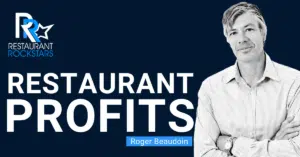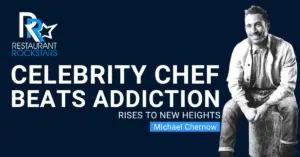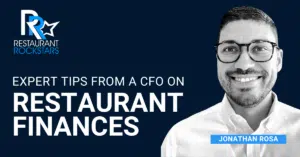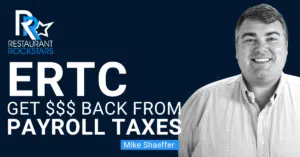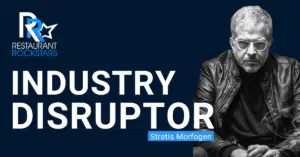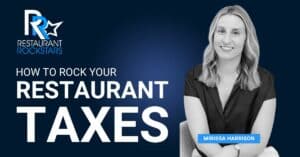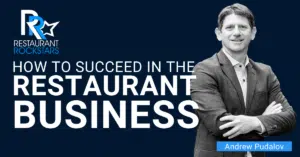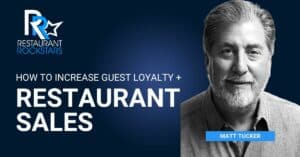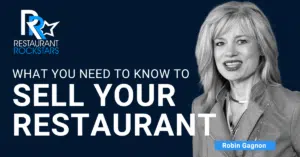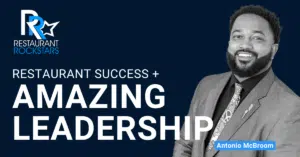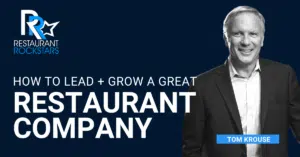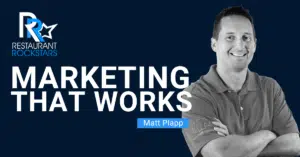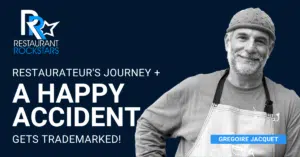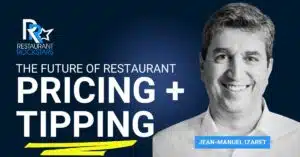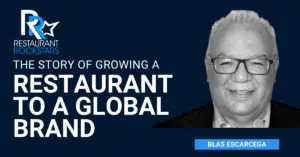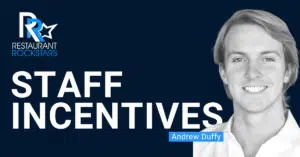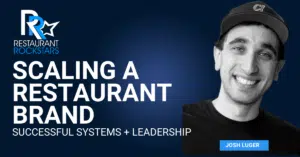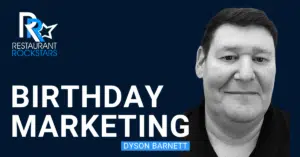Restaurant Rockstars Episode 322
Restaurant Franchise Rocks After 100 Years
LISTEN HERE OR ON YOUR FAVORITE PODCAST PLAYER
Prefer to watch the interview?
Click the video below.
What other restaurant franchise is still successful after 100 years?
Fifty years ago, my family would drive in, the car hop would attach a tray to our car window and then bring the frosty cold mug of Root Beer, the Cheeseburgers and the ice cream sundaes…. I can still taste that experience and feel it today.
It’s nostalgic and all-American!
In this episode of the Restaurant Rockstars Podcast, I’m speaking with John Palumbo, Sr. Director of Restaurant Franchise Development for the famous A & W chain.
Listen or watch as John talks about:
- The history and secret to 100 years of success
- What has changed and stayed the same over 10 decades of business
- Rising costs, the labor crisis, supply chain challenges and other pain points
- The R & D process for new menu items
- Critical systems for operator success
- Loyalty and Marketing that works
And of the course, the A & W Restaurant Franchise opportunity at www.awrestaurants.com
Watch or Listen to this episode and then go out there and Rock YOUR Restaurant!
Roger
Connect with our guest:
Twitter: https://twitter.com/awrestaurants
Facebook: https://www.facebook.com/awrestaurants
Instagram: https://www.instagram.com/awrestaurants/#
0:00
But we’re able to buy with the power of over 14,000 restaurants when it comes to chicken and beef and lettuce and restaurant equipment and all of that. So that’s really is a big advantage that, you know, quite frankly, folks coming into the system didn’t really realize which I understand.
0:16
Hey there. Thanks for joining me and welcome back to the podcast. It’s about a chain that’s been around for over 100 years that serves burgers and comfort food. It’s known for its car hop service, and of course frosty cold mugs of root beer. I’m sure you know what I’m talking about. So I can’t wait to bring you this episode. So much to learn. Thanks also to the sponsors of this week. That’s Whirks, popmenu, the birthday club and SRV the restaurant training app. Stay tuned. You won’t want to miss this one.
0:49
You’re tuned in to the restaurant rockstars podcast powerful ideas to rock your restaurant. Here’s your host Roger Beaudoin.
1:05
restaurant owners and managers Listen, this is important. If you haven’t heard of the employer retention credit, your business can receive lots of money back from the IRS money you’ve already paid in payroll taxes. Now the ERC program as it’s known is available. If your operation had fewer than 500 employees, you had to shut down or partially suspend your business or you had at least a 20% reduction in business due to COVID 19 in any quarter of 2020 and the first three quarters of 2021. Now how much is the credit up to $7,000 back per employee per quarter for 2021 and up to $5,000 per employee in 2020. Listen if you have 10 employees today and meet the requirements you could receive up to $260,000 back in a refundable tax credit. Now the faster you apply, the faster you get the cash. Think of it as found money that you can use for any purpose payroll cost of goods, business improvement or other business expenses. Again, best of all, you do not need to pay this money back now works as a company that will do all the heavy lifting for you and get your business back the money that’s due. I’m speaking from experience here with works I received a sizable amount back in all available quarters from my former restaurant and I couldn’t be more pleased with their service their people and their process. FOR A NO OBLIGATION console. Click the link for works in the show notes to this episode. Don’t miss out. Get your consult today.
rockstars restaurants have been hit hard the last few years which means restaurant owners and staff are working harder than ever trying to meet the demands of in person hospitality can be really demanding, which is why I recommend popmenu answering pot menu answering turns every phone call into an opportunity. It uses artificial intelligence to answer the simple questions that are tying up your phone lines like can I make a reservation or where are you located, and over 50% of restaurant guests are happy to have their questions answered by an automated system. Within the popmenu platform. You can customize answers for your restaurant and choose the voice your guests here and even send follow up links via text message. Popmenu answering picks up your phone 24/7 365 days a year allowing you and your team to focus on what matters most pleasing your guests, prevent lost customers and impress your guests with popmenu answering. And for a limited time my listeners can get $100 off their first month plus lock in one unchanging monthly rate at popmenu.com/rockstars go now to get $100 off your first month and learn more about popmenus full collection of tools at pop menu.com/rockstars rock on!
Welcome back everyone. This is the restaurant rockstars podcast with me today Mr. John Palumbo. He is the senior director of franchise operations for that iconic classic American chain, A & W root beer. Welcome to the show. John, how are you?
4:13
I’m doing well. Thank you, Roger. Thanks for having me.
4:15
So I think you’re making all of us hungry because the background first of all is like really beautiful and the root beer is right there. And we could just like dive on in into your background right now because I don’t know, my audience is all over the world. But it’s lunchtime where I am. So anyway, it brings me back because you know, as a kid growing up in Western Massachusetts, a and w is definitely a staple in our family and back then they had the car hop service, you know, with the trays and the windows and the frosty cold mugs or root beer and the burgers and it really really brings me back even though that was so many decades ago. And yet this iconic brand, you know, it just continues 100 plus years later so we’re gonna talk all about what makes the brand special And you know what’s changed over years? What’s the same? But let’s start with how you got into this business. Everyone’s got a story. What’s your job?
5:08
Yeah, so I thank you. And I feel like I’m over 100 years old sometimes, by the way, myself, but my family I’m a Brooklyn kid born and raised. We had pizzeria restaurants growing up all through my life. And so when there was, you know, home from the summers in high school, or back from college, I was in the restaurants working. And so it’s, it’s funny to realize my career is in is in restaurants and in food, but it’s, it’s in a franchise model, a side verse, an independent, you know, restaurant, a tour, so to speak. I kind of always thought that was maybe my path. I played baseball for a long time post post high school as well. And I, you know, realized I wasn’t gonna play for the Mets. Although there were years where I probably could have not, it’s
5:59
hitting so you were serious about it? Well, I was born, they weren’t serious about you. You were serious about them.
6:07
Correct. So, so when I graduated, I went into the college, I went into the sports and recreation industry, I ran a not for profit and for profit, recreation centers, community centers, private health clubs. And then out of nowhere, we had some restaurant space that was available in the one of the clubs I was managing, and it wasn’t being used. And I said, Well, wow, what a great opportunity to utilize some of this restaurant and juice bar space as an accommodation for our members and another profit revenue revenue center. And so I started requesting RFPs from franchisors actually in was sort of my first segue into franchising and going through the RFP process and talking to different franchisors, I realized what made franchisors good, what made them feel maybe not as good, learned about support mechanisms, and all that kind of stuff. And from there, that was my first real experience with franchising and franchise food. And so, quite literally, I got to know the franchisor, who came into our club and US renting out that lease that restaurant space. And I became very friendly with them. And they said, Hey, you really shouldn’t be in franchise development. And I said, Well, what is that sales? I’m I really don’t do sales. And he’s like, yeah. I said, Well, I just develop stuff. And I, you know, build relationships. Long story short, I started my career, moved out to Arizona just had my first child at a time. And yes, it’s often running in franchise food. Who knew? And here I am Three years later,
7:52
still, and so it started with pizzerias. Hmm. It did. Wow. Well, you know, it’s funny, because I never thought I’d be in the restaurant business as a young guy out of college. And, you know, going into graduate school years later, I had an opportunity to live in Italy. And then all of a sudden, this pizza thing just came out of nowhere. And I just started eating woodfired pizza on every street corner for like, two months, you know. And then when I came back, and graduated, it’s like, I came up with this idea, like, wow, wood fired brick oven pizza, no more sophisticated concept. And I started my first restaurant with no restaurant experience, but it was a pizza concept. And that led to everything else, the whole hospitality thing went from there. So that’s cool that we share that in common. Let’s talk about the history of a and w because everyone listening knows of A&W, maybe they have one nearby, maybe they have memories like I do of being a kid and what that really meant. So there’s an aura around the brand. And it’s definitely that apple pie, classic baseball, Americana feeling, at least for me, that’s what I get. But tell us about the history. And tell us about what the brand means to you. And, you know, new franchisees that are coming into the fold. It’s like, what’s the, you know, what’s the aura of that brand that I’m trying to describe? That’s just my own feeling. You know, tell us about what What’s your perspective on that?
9:11
Yeah, what’s really cool about this brand is everyone we get to talk to, and what I do every day my team does, we talk to folks who are looking to gain entry into the system. And it usually one of these initial conversations will start with, Hey, I used to go to an A&W or I remember the root beer float or, you know, or some kind of real connection to this. Emotionally. Yes. Yeah. And so it’s just so cool because I get to learn a little bit about you know, folks perspective, quite honestly a few times a week from different people and so, so yes, it is definitely a brand that people gravitate towards and have this emotional connection to. Started over 100 years ago was started with the root beer stand, California. And, you know, we started franchising from that root beer stand You know, mid 20s, quite a crazy to say right mid 20s Just, you know, literally years after we launched it. And still, we like to say where the original craft beverage is that root beer was made fresh in that root beer stand, you know, over 100 years ago, and we opened up a new restaurant in Arnold, Missouri this week, actually, it’s, it’s now its eighth day open. And we’re making it still in our restaurants fresh every day still served in a cold frosty mug has never changed. And so, folks, you know, we quite literally have three or four generations of we call them brand fans, fans of the brand. And
10:44
yeah, raving fans. Yeah, I
10:46
mean, we have three or four generations of franchisees. And it’s, we’re very blessed to be able to say that, and this brand has gone through many different iterations. And as as it should be in 100 years old, and but what’s always kind of remained the same is that connection to, like you said, real Americana food and the root beer, the root beer floats, you know, it’s a quality brand, we don’t play in like the value menu category is just not what we do. We still enjoy a lot of percentage of folks that dine in. And so when a time what were some restaurants maybe look into shrink their footprint for a lot of reasons and a lot that makes sense, right? The financial, right? We’re not, that’s not what we want to do. Because you just can’t serve that frosty mug out of a drive thru window.
11:39
That’s right. And you’re making an interesting point, because when the pandemic hit and whatnot, your franchisees literally kept their dining rooms open to the extent possible. And again, you didn’t shrink the footprint, and you continue to make it work. And that’s really remarkable, because you know, so many other restaurants were one forced to close to close their dining rooms, pivot to different business models, all that kind of stuff. Yet A&W state tried and true to that original formula.
12:03
Yeah, we sure did. And by no accounts, we believe that our business will ever gravitate to Oh transition to you know, 80% dining 20 drive thru. But we will play around that 60 70% drive thru some restaurants, it’s actually pretty big split actually dining room and drive thru. But we’ll never be a drive thru only or 80 90% drive thru business. People connect to that mug, and you just can’t be can’t understated. And the beverage is very different from us, in store and in restaurant experience versus off the shelf in a supermarket. It’s a totally different product.
12:47
Well, I know you can’t give away any trade secrets or recipes. And I certainly won’t ask you for that. But what’s really interesting is that part of your training for franchisees is obviously teaching them how you recreate an original formula that has been so old and so iconic, and continue to do it, like you say fresh in the stores each and every day or each and every week, and give people that consistent experience that they’ve come to remember for decades, and multiple generations. It’s the same, it’s authentic. I mean, that’s, that’s so rare in this business, you know, to have something that historic, that stays the same and people remember it and their grandkids get the same experience that grandparents had. I mean, that’s awesome. I love that. Yeah,
13:27
yeah, it is, it really is. And what’s what’s cool too, is when we look at year over year numbers with drink incidence in the QSR category of AWS consecutively wanting to from percentage growth on drink incidents, and you know, we’re certainly not the biggest terms a number of restaurants and so it’s, it’s kind of cool and we attribute that of course, to the A&W product and you know, in the menu which has changed in a lot of different ways and I’m sure we could talk about that but it’s the brand that has, you know, Roger said it’s we have been around over 100 years and from ownership structure to processes and operations you know, things have changed, however, we believe and maybe I’m biased but we’ve never been in a better position. And it’s hard to you know, hard to really be able to say that when you’re a brand of our age.
14:23
This is so true. Like I’m a big history buff you know and the birth of the automobile and the 1920s and all that kind of stuff obviously opened up the opportunities for your brand to expand and then the National Highway System creation and all that kind of stuff and people you know growing up in a certain area and then traveling parts of the country and still seeing A&W wherever they go and getting that consistent experience and that’s still true to this day. You know my family sold our restaurant two years ago we moved west we got an RV and the kids and we traveled the country. And yes, there are A&W is along the route. You know wherever you go. And that’s that’s just, you know, maintaining that that proud history that you have. So let’s talk about what has changed versus what wasn’t broken, didn’t need to be fixed. I mean, a restaurant has to keep evolving to stay relevant with its customer. But again, you can’t fix what isn’t broken, you can’t take away the tried and true, there was iconic things that define the brand, yet, you obviously have an r&d process and new menu items, and, you know, limited time offers all this is part of your business. How much of that? Do you know does a and w get involved in and how often does it happen? And what is the r&d process and all that? Let’s start there?
15:39
Yeah, sure. So we, you know, I think when we get back to kind of what what we, you know, what we did on the r&d side, and kind of what’s been the response, you know, what, what’s responsible for this growth over this past decade? Specifically, I think, the ownership structure Roger, where we went, you know, 10 years ago, we were bought, we were owned by yum brands. Of course, yep. And so, you know, our franchisees, our largest international franchise partner, and our US Franchise Association came together and bought that brand back from yum. And so when we say franchise partners, we’re, quite literally, it’s our franchise partners. And that’s what we work for. That’s who I work for. That’s always been sort of my mindset, regardless, because that should be every franchise was mindset. Yeah, we’re there to serve at the pleasure of our franchisee community and grow the brand, in a responsible way, etc. But in this case, it’s actually true. And so that was the first kind of big, you know, rock that we worked to push up the mountain. And then with that became a, Hey, let’s go back to what made us really so. So great. And that was our freestanding, you know, single brand drive thru restaurants with a nice dining sized dining room and, and so focusing on increasing steam source sales first, before we look to grow. And so these past 10 years, literally this past decade, we’re up over 67% see incredible sales.
17:09
Yeah, that’s incredible. Yeah, and
17:11
it’s pretty, it’s you know, it’s not just post pandemic, it’s, you know, pre pandemic, and then pre pre pre pre pre pandemic. 10 years, you know, and yeah, wow. Yeah. And so it started there. With, hey, you know, we’re gonna look to grow zero new restaurants, let’s figure out how we drive same store profitable sales growth, not just same store sales growth. And so yeah, and that’s where it started. And then it became consistency. You know, our leadership team on the executive level, has been with this brand for many, many years, over 25 years, our president and CEO is, you know, you chatted with Kevin, as you said, I did an advisor and came back to the brand when when the franchisees bought their brand back and, and with that became that sense of consistency, again, a sense of calm. And also knowing that we’re not owned by private equity, or owned by Wall Street, we’re not looking to be sold tomorrow, our franchise partners put all the money back into the business. And so that allows franchisees to take a deep breath again, and start reinvesting in their restaurants, looking to grow again, over time, same store sales and coming up. And it’s kind of like the good old days and that way and so we had some product innovation, as you mentioned, and I’m sorry, I just wanted to set that up.
18:32
No, please. Yeah, that’s all relevant information. Thanks for sharing.
18:35
Sure. And so as same store sales grew, we started looking at menu innovation as well as how best to you know, like everyone structure a menu visually and so we had a major rent menu revamp and so with that came, we have a whole town’s favorite menu not to get in the weeds too much. Which essentially each restaurant which makes us unique is able to put some menu items that specific to that community. That’s you know, hey, I have to have on the Cape, we’re gonna have fried lots of fried clams it’s just gonna have
19:14
that makes that makes sense. Yeah, you won’t see it in Iowa shares. Yeah, but you’ll see something different in Iowa that you won’t see in Massachusetts so you got your core menu obviously which is what people remember that they can get anywhere but then you know, that’s a critical point because different franchises have different rules about what a franchisee can and cannot do. And some are more open to new ideas and that sort of thing. And others are like Nope, this is the formula you don’t deviate from it it’s got to be rock solid consistent from one store to the next and every franchisee. You know, every franchise is a little different. But it’s really good to hear that you know, that you that you open that up to what’s important in a community because I think that adds to your success as well, and I’m sure it definitely pleases your franchisees.
19:56
Yeah, it does, and we, you know, we’re available and we’re very involved with that process and, you know, we want to be careful with food costs. If we saw, you know, we start looking at our hometowns favorite menu, what happens is it goes outside most cases might go outside of our traditional, you know, food purchasing Co Op. And so that becomes, you know, you’re gonna manage costs and costs engineering backwards. But But yeah, we we help out every step of the way with that and make sure it works. We apply the right marketing support for it. And, yeah, and what’s this new menu revamp? You know, we have, we rearranged our core menu items a little bit, reduced the hometown Favorites menu a little bit. And, you know, we’re just super blessed to be in this position where it’s been so well received from our franchise partners, and the fans of our brand, quite frankly,
20:55
well, large companies like yours, obviously have economies of scale and buying power and all that sort of thing, which obviously gets passed on to the franchisees, which is awesome. But regardless of that, whether you’re independent, or you’re a large company, everyone is still battling the supply chain shortages. And suddenly products not available, that is a step menu. And if it is available, the price is doubled. And, you know, there’s so many domino effects that are happening right now the labor crisis, how is a NW dealing with all those things? And how do you, you know, how do you guide your franchisees through the stormy seas that are still happening right now?
21:30
Yeah, absolutely. To say it’s still happening, right. So two or so years later, yeah, unbelievable. But it is still happening. And so we’re also very fortunate instruction in a way that so we’re part of the RSCs, that’s the largest, it’s yums, food purchasing Co Op. So once we brand came back to us, and we bought the brand back franchisees that from Yum, we maintain that relationship. And that’s been pivotal. So first restaurant of our size with you know, 600 Someone restaurants between freestanding and, you know, co brand restaurants, we still have, aw, KFC, Zayn, wn, Long John Silver’s, and we have some different cold brands. So we’re not building new ones, in years, but we’re able to buy with the power of over 14,000 restaurants, when it comes to the chicken and beef and lettuce and restaurant equipment and all that. So that’s really is a big advantage that, you know, quite frankly, folks coming into the system didn’t really realize which I understand, you’re talking about a real real difference in profitability. But we’re on top of it, Roger, were able to take advantage of the learnings and the six month crop reports that are out and locking in, you know, dairy prices, and nine months from now. And all the things that if we didn’t have that relationship with the RSCs, at random massages put in do, we wouldn’t have the resources or the money to be able to do that. And so while we’ve been affected everybody has, we’ve certainly fared better than many. And that’s, you know, unfortunate. And we mean that we’ve you know, any restaurant as you know, that might struggle, whether it’s an a and w or any other brand, any course any other category. If this is your wife, like it’s ours, it hurts a little. And so, but we have, like I said, we’ve been blessed and fortunate to do a little better than most, but it’s data and it’s information that systems planning and processes. And that’s how we manage it. Week by week, day by day basis.
23:38
Let’s talk about systems because that’s a critical component of any restaurant, obviously. And the guests know when a restaurant is or an operation is really dialed versus one that’s kind of running by the seat of its pants. And, you know, people are tied to their businesses now more than ever, but the systems are really what allows them to deliver amazing guest service to customers and making sure that the consistency in the products we’re serving is there, what what systems are in place that are most important that are really turnkey and easy for new franchisees coming into your system? Would you say into your operation?
24:12
Sure, sure. So a couple of things. One, we created and started aw, aw University. Yeah, that’s in in Lexington, Kentucky. And that’s where our corporate headquarters are. And so we have our company restaurant with a whole classroom set up on the back of that building. And it’s funny because when folks go through that, they say, Well, we’re going to build a restaurant we want that classroom to say you don’t need a classroom, you want to save the money in the real estate please get up. But that’s simply the first you know, experience there but so with that became a full fledged robust training program, which it doesn’t start and stop. After folks come into the system and get into their restaurant. It’s ongoing we retrain manage Just come through to a training program from specifically designed five days and 10 days anytime they want at no cost until they come back through our program. So it’s ongoing training, you hire any general manager, guess what send them to? Aw, yep, bring them in. And so we do that. And then of course, we have more robust field training team that’s out in the stores, as folks get open after they get open. And throughout, they periodically are involved, in addition to our franchise growth leaders may just feel a marketing team, training team. And so those systems were important on the front end. And then things like, you know, I said, we make our own root beer. Well, we were able to innovate in the way of the preparation to do it, we were able to cut the time down and have a safe, consistent product with something as simple as a mixer. You wouldn’t believe this, but not too long ago. And there are some restaurants that still may do it, we will mix in our root beer by hand in the big vats with a big stick. And so it’s pretty amazing. And we were always kind of like, whoa, we can’t mess up this recipe. I don’t have an automatic mixer, you know? Yeah.
26:12
Yes. So let’s This is really fascinating to me. I’m envisioning. We’ve all seen these microbrewery brew pub type places that display the big tanks, and they’re actually brewing, whether the customer guests are there, they’re not, you know, the processes going on? How elaborate is the, you know, the root beer system in an individual location? What’s the process? How long does it take? And, you know, is it really complicated? Is it simpler than one might think, and again, don’t give away any trade secret is fascinating to think about every day. It’s like your operators making this classic product, and they need a certain amount of equipment to do it. And they need to do that process consistently, right, every single time. And there’s refrigeration involved, and there’s mixing, like you just said, and yeah, tell us about that. That’s awesome. Yeah, it’s
26:58
very cool. And so yeah, it was easier than I thought it was gonna be no, I’m a little bit of a ops experience, but not not nearly as
27:07
fatigued. Yeah, but you’ve seen it numerous times, I’m sure. Yeah. And
27:11
so it’s, it’s, it’s a little time consuming. But you can make, you know, a batch a couple of hours. And you can make it for a couple of days.
27:19
How much how much is made at a time and to serve? How many people kind of thing?
27:25
Yeah, that’s a good question. I should know that offhand. But I don’t know that the gallonage but typically are Yeah, typically we serve. You know, our batch of groupID is made is usually a day ish day and a half ish. And it’s made, and then it’s made again, whether we Okay, yeah, you’re selling it. And so what happens is it gets made, it gets mixed. And then it gets put into a, essentially a keg system that gets transported into it. Right, sealed sets. And then it goes into our keg system. And it gets actually poured from a draft on it’s not a little push button. Yeah, it’s real draft repair. Absolutely. Yeah. And that’s where and that’s where it gets poor from. Yeah.
28:04
So how does that product vary, because they know that you can buy A&W root beer in supermarkets and that sort of thing. And obviously, it’s a carbonated beverage. And it has to be, you know, it has to maintain shelf life and all that kind of stuff. And now it’s in a can or a bottle, or whatever the process is, but the real draft process happens in the stores, but then something similar happens. But it still tastes the same. Or it still gives you that a NW feeling even though the process has to be slightly different.
28:30
Yeah, so I believe that if you you know, address root beer from our restaurant and a can from a supermarket is so dramatically different, like not even close. And we don’t control the canteen bottling ranges. So you know, that’s not part of our system. That’s yeah, that’s right. It’s
28:49
a separate entity. Yeah, right. Yeah.
28:51
And so while the recipes are similar, there would just be impossible to duplicate it. And I just, I mean, it’s just so night and day to taste the
29:02
taste of the real, authentic product, you got to get in the story if you want the real authentic product. Well, thanks for sharing that that was important to clarify. We talked about a multiple revenue business model, can you explain what that means. And I know it’s got something to do with the drive thru and the inside dining and all that kind of thing. And obviously, there’s a marketing component of getting people when it’s convenient for them to go through the drive thru, but you also want to get them in the in dining experience and just keep them in the fold as much as you can. But explain what that concept means.
Listen, I’m all about marketing. But believe me, very few marketing ideas today are fully trackable where you know exactly where the business is coming from. And you also know that it’s generating a positive return on your investment. Now, I no longer own restaurants, but if I did, this idea would be at the very top of my marketing plan. It’s all about birthdays. Everyone has a birthday and they are a huge Let me repeat that huge source of business in your restaurant. Why? Wouldn’t you want to focus in on reaching everyone with a birthday in your area? Well, you can with the birthday club from fan Connect. Best part is they do everything for you. You get a turnkey marketing system that sends birthday cards in advance, inviting people to celebrate your restaurant from your area code, plus a sign up strategy for your existing customers. New business, repeat business hire check averages and a massive customer database, you can get all this with the birthday club, check it out and sign up now at get fan connect.com/birthdayRockstar.
30:41
Yeah, so we want to be accessible and available and serve our customers how they want to be served as best we can. And so we can serve, you know, a frosty mug outside of the drive thru window. But we can inside and so we want to provide multiple opportunities for revenue and for customers to, you know, be a part of our experience. And so that’s why we have our dining room platform open platform open, we did switch to a new restaurants are being built with a dual order point, which is very common nowadays, as well as some cooler head spaces and an escape lane. So we changed our our exterior footprint a little bit. Not really as an as a result of COVID, but not really not Professor COVID. So, you know, at some point, a dining room was worth close because they had to be part of the city or county or state. Of course, we all went through that. Yep. Yeah, yeah. And so, but with that, of course, became, you know, more drive through x 50. And so we had to kind of thing pretty quick out of the box. And so we went to handhelds, and with you know, flipping technology a little bit, and, you know, trying to do third party ordering, a lot of our customers in take to that necessarily a little more so now. But we’re still very much a ham on ordering AWS through a third party delivery system. Not nearly as much as other other brands in our category. But we do have that as an option. We also have again, your you can order ahead. And you know, that’s something we’re implementing now that online ordering piece which is endorsed. Yeah, that’s not necessarily revenue. Yeah. And other revenue. Okay. And so we do we have what we had all, you know, we call the poor, kind of cool for, you know, dine in pickup delivery drive thru
32:39
of your operations, experienced extreme difficulties with the labor crisis? And how are your individual operators dealing with that right now, are there any, you know, ideas that you’ve come up with that have really helped your operators, anything innovative, anything, you know, new and exciting that you’d like to share?
32:56
Yeah, so we are also really blessed in that we have a lot of franchise owner operators that are in the store a lot. We certainly have large multi unit operators, 14 restaurants, 15, restaurants that can’t be everywhere. But as you know, but, but the ones that are in their individual stores, they seem to be able to make your work a little easier. But there really wasn’t a major secret, Roger to, in the height of it all to getting, you know, to really getting those extra set of hands in to the restaurants to help. What we started doing was just talking about ways and trainings and how to expediate the ordering process of Cook line. And not and still maintain the integrity of the product. We were very transparent with our guests. And we also got a lot of grace, like most folks did Darn COVID with a little longer cook to order times. And, you know, sorry, we got to close a couple of hours earlier today. We didn’t get product yesterday, you know, that happened periodically. But again, as such, you know, it’s far less with our brand because of our cooperative relationship. But there really wasn’t a magic bullet in you know, in terms of the staffing piece. What else, you know, what I’ll say is once we’ve started coming out of it, so to speak, and labor as you know, you look around, it’s still a challenge for a lot of places. Right? Yeah. But I think our social media presence, which we have, you know, remarkably, a huge presence on social media. And we’re really fun brand to follow on Instagram and Facebook, and it’s just an all of that, you know, has helped us attract talent to our restaurants to work because it’s a fun brand to be a part of. And so when we came out of it, we started seeing I think we will I’ll tell you some real kind of, you know, real conversations that we had with our franchisees couple months ago, we had our quarterly meeting set up in the upper Midwest, and we were all together there and to a franchisee it was like, you know, things are getting better in the labor piece. Not so bad now for me, I’d like a few more, but that’s okay. We just start with the bottom, Missouri and we hired, you know, 55 people, and we’re gonna hire another 20. And we have applications to do it. So, I don’t know, though, you know, we have the magic bullet, but it does help me in a brand that people want to work for and being a part of a culture and from top to bottom that, you know, we will wash in the same direction. So that’s the labor piece.
35:44
Let’s go back to r&d for a moment, you, I would guess that you’ve got a corporate executive chef type guy who comes or lady that comes up with new menu items from time to time, or these limited time offer kind of things and what happens then upper management sort of tastes the idea and thinks it’s going to work and translate across the country. So then you do that marketing focus group thing, and you get your raving fans to come in there to tell you what they think. And if it’s a hit, and you roll it out regionally and try it here. And if it’s a hit there, then it go. Is it anything like that? Or am I way off base?
36:15
Um, so it’s a little bit of that a little bit not in that. And so we have, we don’t have an executive chef, per se, but we do have is r&d team. And we share that in house, as well as really RSCs. And so we look at say limited time offers, will looking out, you know when to now you know, q1 23, right.
36:41
Sure. Yeah. Yeah. Something out, it’s going to take months, of course, yeah. And
36:47
so we look orders, cost engineering, we see well, what’s the if we want to do say a bacon promo or ham promo, we want to look at and say, what’s the market is going to look like six months from now, we want to again, make sure our franchisees are profitable. So we don’t want to give them an LTO. That means they’re losing 37 cents per transaction. And so once we figure out what we want to do, our franchise Advisory Council, or novel board, national Aw, Franchise Association, has a marketing subcommittee that are involved in all these decisions. So quite literally, our franchisees and so we have a touch Test Kitchen in our corporate headquarters, we have corporate restaurants. And so we start rolling out, Hey, this is what seven different options, this is what we want to do. Here’s the the build on it, you know, the job eight is the unit economics are of course, engineered the lto. Of course, this is how many cases we’ll have to guarantee and distributor in order to be able to pull off the LTO and and then quite literally eat a lot of food for a week. And you’re like, This is horrible. Yeah, this is really good. It’s like, well, we can’t have that so expensive. Well, Mike, why don’t you give it to me?
38:05
I know, right? Well, of course, the bean counters gotta get involved. And you got to make sure that it’s not going to steal profits from something else on the menu, and you know, and just cannibalize sales of something that makes it the individual operator a lot of money. And, you know, that’s a place where a lot of restaurant operators really go wrong, they don’t design their menu where everything contributes a similar profit in each category. And the spread sometimes is dollars. And the most popular items seem to be the least profitable. And it’s like, okay, I’m filling my seats. And I’m wondering why my bank accounts not growing. And, you know, that’s where large companies really have that dialed right down to the penny, where everything is designed as a system. And it’s designed to work and maximize guest value, of course, because value is in a super important part of the equation consistency. And again, the profitability just has to be there to give, obviously, the economy a boost and make sure everyone stays in business. That’s
38:57
yeah, sure, we have to lean on. Again, we lean on quality, because we’ll never be a value brand and product innovation r&d, for instance, was you know, our hand breaded chicken tenders and on frozen and made fresh to fry to order breaded and fried to order. You know, that’s not all over television, because we don’t have the marketing budget to do that on the AD AD side,
39:22
but it’s a stand for quality. And the individual operators obviously need to tout that because it’s a competitive advantage. It’s not you know, frozen, it’s, you know, it is hand breaded and it’s natural. Yeah, I mean, all that
39:35
little longer. Yeah, that’s where our Advisory Council on our franchisees and our team just like, waiting a little longer are really good price points and you know, and it just works for us our you know, our cheese curds again, I’m getting in the weeds a little bit sorry, but it’s fine, fellas. 100% Wisconsin white cheddar made from the same place and just unbelievable. You know, you can ship from here or there and you know, but
40:04
no, Wisconsin’s known for its cheese. Yeah,
40:06
sure is and so, so things like that I mean, you know, product innovation. Our franchisees have seen it and have their taste buds all over it through their advisory council they who they vote for? Yeah.
40:21
Well, you’re known for your root beer, you’re known for your food, you’re known for the vibe of the stores, obviously, the iconic brown and orange colors. What about service philosophies, because that’s such an important system into itself delivering what we call hospitality, which is the foundation of this business. That must be, you know, it’s all part of the onboarding process. It has to be in each individual store, it goes beyond just hiring good people. It’s like, they’ve got to have a real desire to serve the public and to make friends with people and to obviously be a reason ambassadors really behind each individual location. Is there any specific staff onboarding, training or hospitality, ongoing stuff that the franchisees try to obviously maintain within each store so that that consistency and that service and that friendly and the smiles and the thank yous and all that stuff is part of it?
41:12
Yeah, so we do. So we have, as part of our onboarding, training, a Wu has modules on soft skills, client facing behavior and things like that, and, and then it really gets drilled into the franchisees owners to ultimately pick to reinforce that with their, with their staff. And they for the most part, and there are exceptions, you know, they do a pretty good job. And we know that because we get feedback from chat meter and online surveys. And as you know, someone’s not happy. They were like, you know, absolutely. And we, you know, we talked about and we use it as not a gotcha, but a hey, you know, this is this is an issue, and let’s talk through it, and how do we get better? And, and again, I think because, you know, I mean, it’s just that we’ve been doing it a long time, for sure. Right. But like, I think the the where we sit today, it’s just so important, everybody is is competitive to every dollar, that any little reason you give someone for not coming back to you for recommending, you know, shame on us. And so it really sits at the forefront of customer service, and it gets walked from the top down, you know, so we walked the walk, I guess that whether it’s in the our headquarters or sports center, restaurants Support Center, or if it’s in the field with our franchisees or corporate restaurant staff, whatever it is, we have to be that engaging, and that available and accessible, as well. And so, you know, we went back to in person meetings, probably before a lot of people, we went back out to visiting heeled, field, visiting restaurants, getting into the field, having folks into Lexington, interacting, engaging with each other. And there’s just something to be said, for that face to face personal interaction. You can’t duplicate you know, remotely. And so I think all of that speaks to our focus on customer service and great, great guest experience,
43:18
you have to be doing that to achieve the growth numbers that we talked about earlier in the podcast, you know, which very few companies can speak to that kind of consistent growth over time. And that brings to mind a simple concept that every operator, whether it’s an individual, independent restaurant, or it’s five or 10 units, or it’s 5000 units, you got to keep in mind, what is the lifetime value of each and every guest in our restaurants worth over time, and making sure that you continue to build that loyalty, you know, which sort of segues into Do you have any to any specific loyalty programs that bring people back again and again and create that intense, you know, sense of belonging, I call it affinity, you know, it’s like, that’s my place. That’s where we go, that’s where the kids like they go. It’s like, we go there a couple times a week. And it’s our, you know, it’s our place.
44:07
Yeah, and so it’s funny, we last week, we met on a project that’s coming into the ground, and it’s exactly that it’s mobile loyalty apps, and it’s loyalty programs and each franchisee, various franchisees will do something a little different on each community, and it’s not uniform. But we’ll go into a standardized POS system. And that’s going to allow us to do all that. So that’s happening to kind of as we speak, but that’s an important next step for us. But But yeah, we’re very our our franchisees tend to be in our brand tend to be very involved in our communities. We’re still doing car shows that a lot of our restaurants, I
44:47
love that I’m a classroom or guy. Yeah. tastic
44:51
Yeah, yep. And so we have to be very involved. But yeah, formal loyalty program, mobile loyalty app is coming.
44:59
But Talk about what you look for in potential franchisees that come into the fold. Obviously, people are contacting your company frequently, and you have a certain criteria or qualification set, or whatever it is, that’s the first step before you decide, okay, this person is worthy of meetings, and we’re going to find out if this is a great opportunity and where they’re, you know, coming from and what their location is. And then, okay, there’s a contract timeline where, okay, we agree that this is a fit, we’re going to sign a contract. And then what’s the timeline before, you know, from signing the contract to getting that store open on opening day? Could you take us through that sort of process? What you look for qualifications? And then what that timeline looks like to get up and running? With the new? Yes,
45:43
yep. So So we believe Roger that, you know, a franchise or good franchisor should be able to lead candidates through the process of becoming a good restaurant or a good franchisee you kind of feel like if you, if you can’t do that you don’t have a robust training and support team, then you’re not really a franchisor. You know, you’re just allowing folks to sell your products and marketing your brand. And, and so when we say, well, what do we what do we look for? My point is we don’t necessarily, you don’t necessarily need to have restaurant experience to be a franchisee of ours, what we’d like to see is that you have some such sort of, you know, management experience, maybe that you’ve led people, as importantly, you have the ability to want to be part of a system and have the, of course, the financial wherewithal, that’s, that’s important. For sure, yeah. And then if you we do look for folks who maybe have want to be the financial arm, but then they’ll have an operating partner. And if that’s the case, we’ll ask that appointment to be, you know, on the agreement when we can for a small sweat equity percentage, but but the operating structure is very important to us has that restaurant, but operate, how are you going to be profitable, not just, you know, ring the register. So we try to sort through all of that, on the front end, we have a pretty robust discovery day process and due diligence process, our novel board, again, involved as needed, as with any one of our executives, so oftentimes, we’ll talk with candidates on the front end a little unique, but we think it’s important. And, and yeah, so I mean, from that perspective, but that’s the key that they have the social skills that they you know, are LED led a team have hired people or have worked in some sort of business background, they get it from a numbers perspective, doesn’t matter if it’s burgers, or, you know, you name it, you know, baseball bats, I don’t know, you. So that’s kind of the basis of what we look for. And then it’s up to us, really, we take the onus and saying, Hey, set these set these folks up to be successful. So sorry, yeah,
48:03
no, no, is there an average amount of time from literally opening?
48:07
Yeah, sorry. So from No, no, no worries, first call? Yeah, first call with our team to executing a franchise agreement is typically about, on average, it’s about 120 days, ish. And a lot of that is due diligence in between. And so once that happens, it becomes, hey, let’s find a location. So that’s two different conversations from securing a location. You know, that time can vary from, you know, a few months to a year, sometimes your team
48:41
will and it will obviously engage and go to the to that town community, whatever and help them assess different locations, and based on traffic studies, and based on past experience and knowledge and say, this one’s better than that one, and, you know, and you help negotiate leases and do all that kind of stuff.
48:58
Yeah, we do. So my team, and that’s how we’re a little different. Yeah, we were on the floor. We had up new developments or sales process and also real estate from A to Z, as well as franchisee financing. We don’t lend but we help folks coordinate the right font. Right. Right. financing option, but, but yeah, we negotiate leases, we, we help negotiate leases, we procure sites, we put them through our real estate committee. We have a large investment in a couple of different real estate and real estate analytics platforms. We have a robust network of real estate brokers. We don’t think we need a lot we need the right ones in the right places, of course how we maintain those relationships. So literally, if someone came in and said, hey, you know, I fled people before I’ve always been interested in a food. I want to learn to have the financial wherewithal thing come Man, we can train them, teach them how to do it, help them find a location, get them into the right financial structure, and that’s the other piece of it. If it’s not a, you know, they’re gonna be looking at bucket of debt service to where they’re negative EBITA, you know, on our average unit volume right now is over 1.2 million, you know, well, then that doesn’t make sense, right? I mean, we’re not gonna let you do that. And so, though, we’re very involved every step of the way, with someone we hold their hand right through closing on the property, and, and frankly, even the design and construction process we have in house architect and engineer folks, project coordinators, that we you know, sign off on all renderings, of course, but we’re also involved with weekly calls for every single project deck that’s on the board, we have a weekly call with the GC, the architect and the franchisee, and gold at every detail in our project,
50:57
standardized decor, of course, right down to the CD, and the boots, and the colors and all that kind of stuff, right? This, like everything is all standardized across. And you know, you decide together, this is gonna go here, and that’s gonna go there. And there’s table layouts designed for efficiency, and all that kind of stuff is dialed in. And then they place the order, and then it shows up, it gets installed by your in house GC guy and bang, then you’re ready for your grand opening.
51:24
Yeah, that’s right, yeah, and they’ll hide their GC, but they, they’ll work with us to make sure that, you know, they’re on track and, and you know, what everything is standardized for sure, we do, we are a little flexible with like conversion opportunities where we have to be. And that’s what makes us a little different to, for instance, a new location that opened in Orland, Missouri, was a conversion. And we put on three really big garage doors. And so the side slides up cool idea, access into that restaurant and large outside patio seating, and we have the space to do it. So we got a little creative. And you know, and it’s been again, it’s only eight days, but folks are loving that feature to it. And, you know, it also provides an outdoor element if we have a pandemic, and you can’t have indoor seating, you do have outs seriously and you can open up the restaurant. And so that won’t be the norm Roger, but that’s an example of how we can get a little creative when we have to, and where it makes sense financially. We had to tear down cement pillars to do it. We would have said that doesn’t make sense.
52:31
Fantastic. I love how everything is so systemized, so dialed in, so efficient, right down to the cost of a drinking straw. And it’s all done for you. All you have to do is be willing and open to learn, maintain that consistency, follow all the legalities because I’m sure that contracts are, obviously, you paid a lot of money for legal fees to make all that right. You know, it brings to mind that movie The founder about Ray Kroc, that always makes me laugh. Because in the early days of when he’s trying to get McDonald’s off the ground, he’d visit his different franchisees and stuff. And some of them were doing fried chicken. And it’s like, what do you do? And you know, it’s like, some people think there’s always going to be somebody who thinks they got a better way of doing something, even though this tried and true for 100 years. And I’m sure there are stories of, you know, you got the team players, and then you got the people that are like, oh, let’s try this. And let’s try that. You know, it’s just, it’s just funny. But yeah, franchising really should be all about standardized and systems and consistency across the board. That’s great. Do you ever Secret Shop the stores? I mean, do you show up after the fact they’ve been in business a year or so and you just sort of show up and mange make sure. You put your guests hat on, and you walk through the door, maybe unannounced, like, you know, and say, what about this? And what about that? And it’s like,
53:44
yeah, yeah, we we show up? For sure. Yeah, but it’s though, gotcha. What we do show up for sure we don’t Secret Shop.
53:54
Okay, that’s awesome. Well, John, it’s been terrific talking to you. How can people if obviously, the whole point of this is people are always looking for new opportunities. And we do have a restaurant audience and some people may be running successful independent restaurants in our audience, and they’re always looking for the next thing. And this is clearly an operation that’s been around so long, and you can have confidence and trust in the fact that it’s always going to be around and that the support you clearly brought to us that tells us exactly what support is offered. How can people you know, reach out to you or find out more about the franchise opportunity?
54:29
Yeah, thank you, Roger. Yeah, so folks can go to Aw franchising.com. Also, I’m certainly available directly at JayPalumbo@AWrestaurants.com with an S. And we love to talk. Aw, we love to talk franchising. It may not be the right time, Roger right now for someone but it might be the right time in a year from now.
54:54
Exactly. Timing is everything. And this may plant the seed and people always go back to our old episodes and something triggers a thought and you never know. And our goal obviously is to continue to serve the industry and give back and provide as much information as we can to help operators run stronger businesses. So thank you so much for being a great guest on the podcast.
55:13
Thank you, Roger. Really appreciate it. Thanks so much.
55:15
Absolutely. Thanks, everyone for tuning in. That was the restaurant rockstars podcast. We’ll see everyone in the next episode. Please stay well take care.
Thank you so much, John, for sharing all your insights and knowledge on a and w the franchise opportunity and current pain points that restaurants are facing and necessary technology and marketing and loyalty programs and so much more. We had so much to learn from you. So thanks for being with us. Thanks to our audience for tuning in. Can’t wait to see you next time.
Listen, I am a huge believer that service is your restaurants greatest competitive advantage. But we all know that service takes time and commitment, dedication. Well, what if there was a training tool, a single tool that was completely customized to your restaurant brand your menu. Let’s start with photos of the plate presentations, ingredients, romance, notes, allergens, everything that’s important that your staff need to know to present and bring to life your menus for your guests. That includes your wine and beer list. specialty cocktails, everything at their fingertips. Imagine in the back of house that cooks, your new prep cooks or anyone can instantly look at the photos, elicited ingredients with prep times and cooking steps all the important things to produce each dish to perfection. Imagine there’s also table layouts of every dining space in your restaurant with table numbers and even seat numbers because we all know how important it is to deliver the right dish to the right guests. This is a tool designed to enhance hospitality in your restaurant, not replace it. Learn more at srvnow.com That’s srvnow.com Check it out.
56:53
Thanks for listening to the restaurant rockstars podcast for lots of great resources, head over to restaurant rockstars.com See you next time.
Transcribed by https://otter.ai
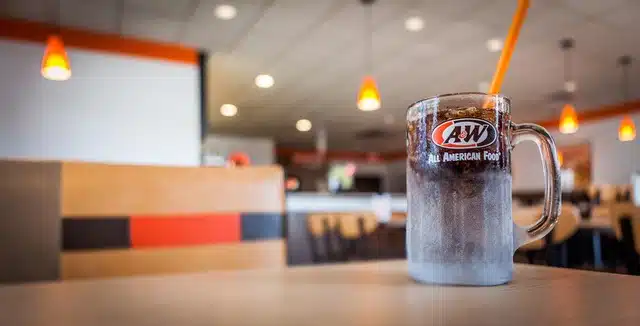
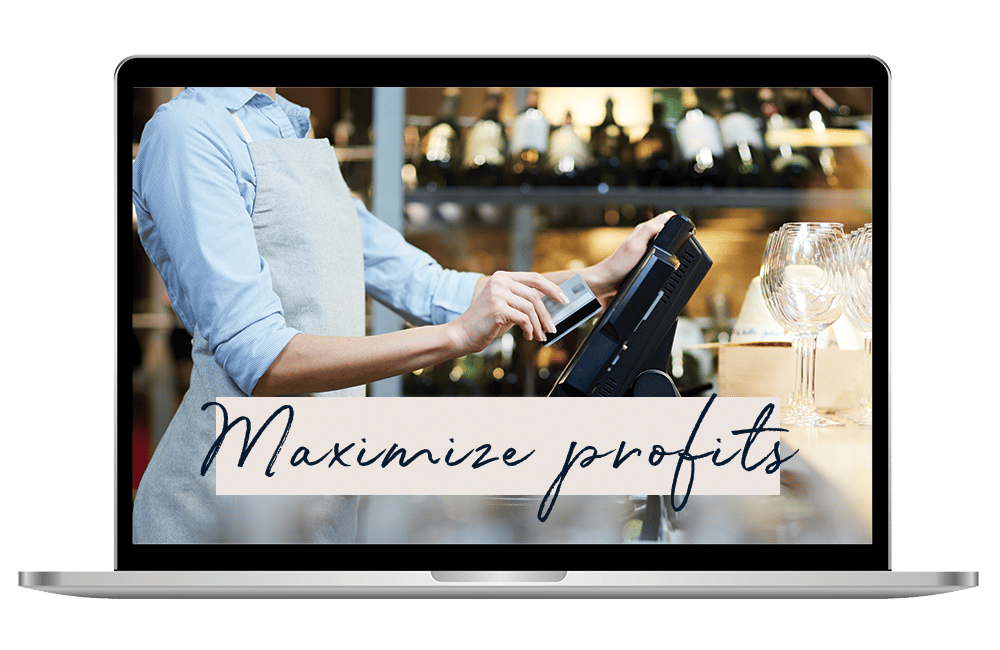
The three costly mistakes you could unknowingly be making?
Find out in this FREE guide and restaurant assessment specifically designed to reveal the unexpected hurdles standing between you and exponential business growth.
Thank You To Our Sponsors
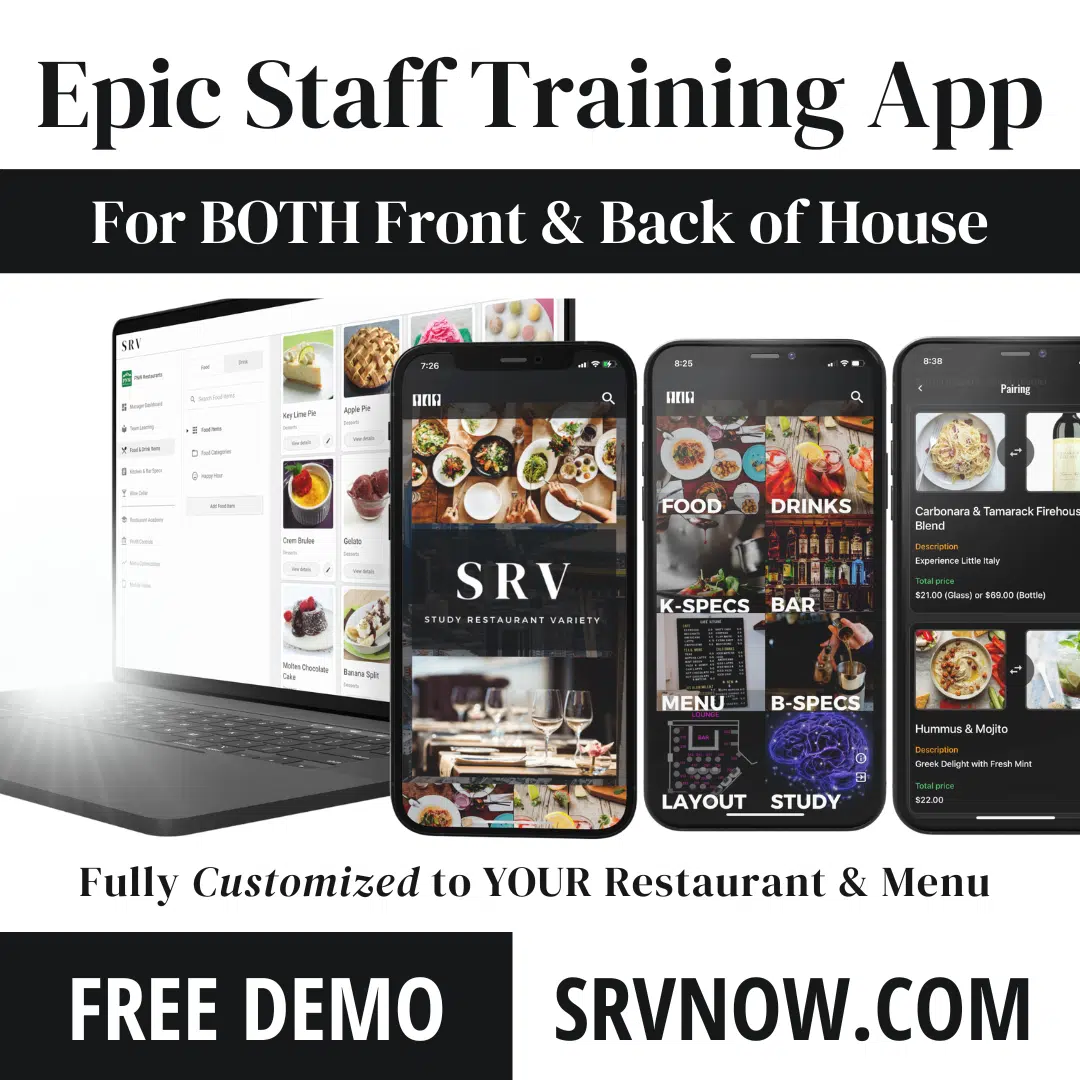
For a limited time only, popmenu is offering our listeners $100 off your first month plus an unchanging lifetime rate.
Request a DEMO:

The Employee Retention Tax Credit We will help you determine your eligibility for 2020 & 2021 - Get Started
Want to become a podcast sponsor?
Please get in touch with Roger at roger@restaurantrockstars.com
